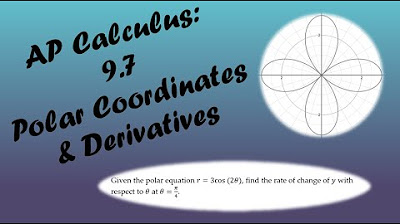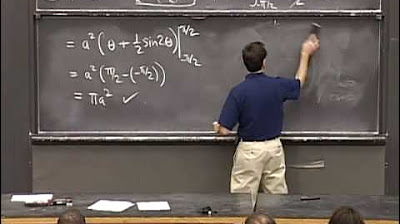AP Calculus BC Lesson 9.8
TLDRThis video delves into the concept of polar integration, contrasting it with Cartesian integration and explaining the transition from rectangular to polar coordinates. It introduces the polar integral formula for calculating the area under a polar curve, using the radius and angle in polar coordinates. The video demonstrates how to set up and solve polar integration problems, including finding the area of regions bounded by polar curves and calculating the average distance from the origin to points on a polar curve. It also addresses the challenge of dividing a polar region into two equal areas with a line of a given slope.
Takeaways
- 📚 Polar integration involves integrating in the X-Y plane using polar coordinates (R, Theta) instead of Cartesian coordinates (x, y).
- 📈 Cartesian integration typically uses rectangles and Riemann sums to approximate areas, while polar integration uses sectors.
- 🔺 The general formula for polar integration to find the area bounded by a polar curve is (1/2)∫[alpha to beta] R^2 dTheta.
- 🌀 When converting from Cartesian to polar coordinates, the formulas X = R*cos(Theta) and Y = R*sin(Theta) are used.
- 🔍 To find polar zeros, set the radius (R) equal to zero and solve for Theta, identifying points where the polar curve passes through the pole.
- 📊 The area of a sector (wedge) of a polar curve is given by A = (1/2)R^2*Theta, where R is the radius and Theta is the angle.
- 🧮 For polar integration, the bounds for the integral are determined by the starting angle (alpha) and the ending angle (beta).
- 🌐 When dealing with polar curves, visualizing the curve can greatly assist in understanding the integration process and identifying the correct bounds.
- 🔎 To calculate the area of a specific region bounded by a polar curve, set up the integral with the appropriate bounds and the squared radius function.
- 📐 The area of a region can also be found using a non-calculator method by setting up the integral with the correct bounds and radius function, then simplifying and evaluating.
- 📝 When given a polar equation, it's often helpful to sketch the curve to understand the shape and determine the correct integration limits.
Q & A
What is the main topic of Lesson 9.8?
-The main topic of Lesson 9.8 is polar integration, specifically focusing on the process of integrating with a single curve in the polar coordinate system.
How does Cartesian integration differ from polar integration?
-In Cartesian integration, we deal with coordinates like (x, y) and use rectangles to approximate the area under a curve. In polar integration, we use polar coordinates (r, θ) and sectors to approximate the area bounded by a polar curve.
What are the coordinates used in polar integration?
-In polar integration, the coordinates used are (r, θ), where r represents the radius and θ is the angle from the x-axis.
What is the general formula for the area of a sector?
-The general formula for the area of a sector is A = (1/2) * r^2 * θ, where r is the radius and θ is the central angle of the sector.
How is the area of a region bounded by a polar curve calculated?
-The area of a region bounded by a polar curve is calculated using the integral formula A = (1/2) * ∫[α to β] r^2 dθ, where α and β are the starting and ending angles, respectively.
What is the significance of finding polar zeros in polar integration?
-Finding polar zeros helps determine the points where the polar curve passes through the origin (pole), which is crucial for identifying the boundaries of the area to be integrated, especially when dealing with loops or petals of polar curves.
How does the video demonstrate the process of polar integration with an example?
-The video demonstrates the process of polar integration by using the example of finding the area of a shaded region bounded by the polar curve r = 4 * cos(2θ). It explains how to determine the starting and ending angles (α and β), set up the integral, and calculate the area using a calculator.
What is the area of the petal bounded by the polar curve r = 4 * cos(2θ)?
-The area of the petal bounded by the polar curve r = 4 * cos(2θ) is 6.283 square units, which can be found by setting up and evaluating the integral as shown in the video.
How does the video explain the concept of Riemann sums in the context of integration?
-The video briefly mentions Riemann sums as a method to approximate the area under a curve by dividing the total area into rectangles (in Cartesian coordinates) or sectors (in polar coordinates) and summing up the areas of these small pieces.
What is the integral formula for the area of a circle in polar coordinates?
-The integral formula for the area of a circle in polar coordinates is A = (1/2) * ∫[π/2 to 3π/2] (2 * cos(θ))^2 dθ, which results in an area of π square units, matching the known area of a circle with radius 1.
How does the video address the concept of average distance from the origin to a point on a polar curve?
-The video introduces the concept of average distance from the origin to a point on a polar curve by explaining how to find the average value of the radius over a given interval. It uses the formula for average value in the context of polar coordinates and provides an example calculation.
Outlines
📚 Introduction to Polar Integration
This paragraph introduces the concept of polar integration, contrasting it with Cartesian integration. It explains that while Cartesian integration uses x, y coordinates and divides areas into rectangles, polar integration uses r (radius), θ (angle) coordinates and divides areas into sectors. The process of finding the area under a curve in Cartesian coordinates involves using Riemann sums and the area formula of a rectangle, which is transformed into an integral. The paragraph then transitions to discussing how to find the area of a region bounded by a polar curve by dividing the area into sectors and using the area formula for a sector to create an integral for the polar curve. The key takeaway is that the area of a region bounded by a polar curve is given by 1/2 the integral of r squared dθ from α to β.
📐 Example: Polar Integration of a Single Petal
The paragraph presents an example of integrating a polar curve to find the area of a single petal-shaped region. It begins by identifying the polar curve equation r = 4cos(2θ) and determining the angles α and β that define the petal. The process of setting up the integral using the area formula for a sector is explained, and the calculation is demonstrated using a calculator in both polar and rectangular modes. The paragraph also introduces the strategy of finding polar zeros to determine the angles that define the petal boundaries. Two different methods for setting up the integral are discussed, both resulting in the same area for the petal, which is 6.283 square units.
🔍 Finding Polar Zeros and Setting Up Integrals
This paragraph delves into the process of finding polar zeros to help set up integrals for polar integration. It uses the example of the polar curve r = 2cosθ and explains how finding when the radius is zero helps determine the points where the curve passes through the pole. The calculation of the area enclosed by the circle is demonstrated, showing that the area is equal to π. The paragraph then moves on to another example, the polar curve r = 6cosθ + 3, and explains how to find the polar zeros and set up the integral for the inner loop of the curve. The area of the inner loop is calculated to be 4.892 square units.
📝 Solving Multiple Choice and Free Response Questions
The paragraph discusses strategies for solving multiple choice and free response questions involving polar integration. It presents a non-calculator multiple-choice question about finding the total area enclosed by a specific polar curve and explains how to identify the correct answer. The paragraph then provides solutions for two free response questions. The first question involves finding the area of a region bounded by a polar curve and the x-axis, with the interval for integration already given. The second question asks for the average distance from the origin to a point on the polar curve within a specified interval, and the paragraph explains how to calculate this average value using integration.
📊 Analyzing Polar Curves and Calculating Areas
The final paragraph presents a free response question involving two polar curves and the calculation of areas for regions bounded by these curves in the first quadrant. The paragraph explains how to find the area of region R using the given polar curve equation and the interval from 0 to π/2. The area calculation involves setting up and evaluating an integral using the given polar curve equation. The paragraph concludes by noting that with the knowledge provided, only part A of the question can be solved, resulting in an area of 0.648 square units.
Mindmap
Keywords
💡Polar Integration
💡Cartesian Integration
💡Riemann Sum
💡Polar Coordinates (r, θ)
💡Area of a Sector
💡Polar Curve
💡Polar Zeros
💡Area Formula
💡Integral
💡Calculator Question
💡Multiple Choice Question
💡Free Response Question
Highlights
Introduction to polar integration and the transition from Cartesian integration.
Explanation of polar coordinates (R, Theta) as opposed to Cartesian coordinates (X, Y).
Conversion of the area formula for a rectangle into a definite integral in Cartesian coordinates.
Description of the sector shape and its use in dividing the area in polar integration.
The area formula for a sector and its transformation into a polar integral.
General process for polar integration involving the integral from alpha to beta of one-half R squared dTheta.
Example of finding the area of a shaded region using polar coordinates and the polar curve R = 4 cos(2Θ).
Explanation of how to determine the starting and ending angles (Alpha and Beta) for polar integration.
Use of polar zeros to find the angles corresponding to a petal-shaped region in polar integration.
Illustration of calculating the area of a petal using both the petal's bounds and polar zeros.
Demonstration of finding the area enclosed by a circle using polar integration with R = 2 cos(Θ).
Process of finding the area of the inner loop of a polar curve R = 6 cos(Θ) + 3.
Explanation of how the value of R affects the shape of the polar curve and the area calculations.
Non-calculator multiple-choice question about finding the total area enclosed by a top loop of a polar curve.
Solution for the area enclosed by the smaller loop of R = 2 + 4 sin(Θ) using polar zeros.
Given the polar curve R = 3Θ + cos(Θ), the area calculation for the region bounded by the curve and the x-axis.
Free response question about finding the area of a region bounded by a polar curve R(Θ) = 3Θ sin(Θ)^2.
Average distance from the origin to a point on the polar curve R(Θ) = 3Θ sin(Θ)^2 over the interval [0, π].
Free response question part C: finding a line through the origin with positive slope M that divides a region into two equal areas without solving an equation involving integrals.
Free response question about finding the area of region R bounded by the polar curve R = (1 + sin(Θ))cos(2Θ) and the x-axis.
Transcripts
Browse More Related Video

AP Calculus BC Lesson 9.7

Calculus 2: Polar Coordinates (Video #30) | Math with Professor V

Lesson 14 - Polar Equations (Calculus 2 Tutor)

Lec 33 | MIT 18.01 Single Variable Calculus, Fall 2007

Double Integration in Polar Coordinates | Example & Derivation

Precalculus: Polar Coordinates (Section 9.1) | Math with Professor V
5.0 / 5 (0 votes)
Thanks for rating: